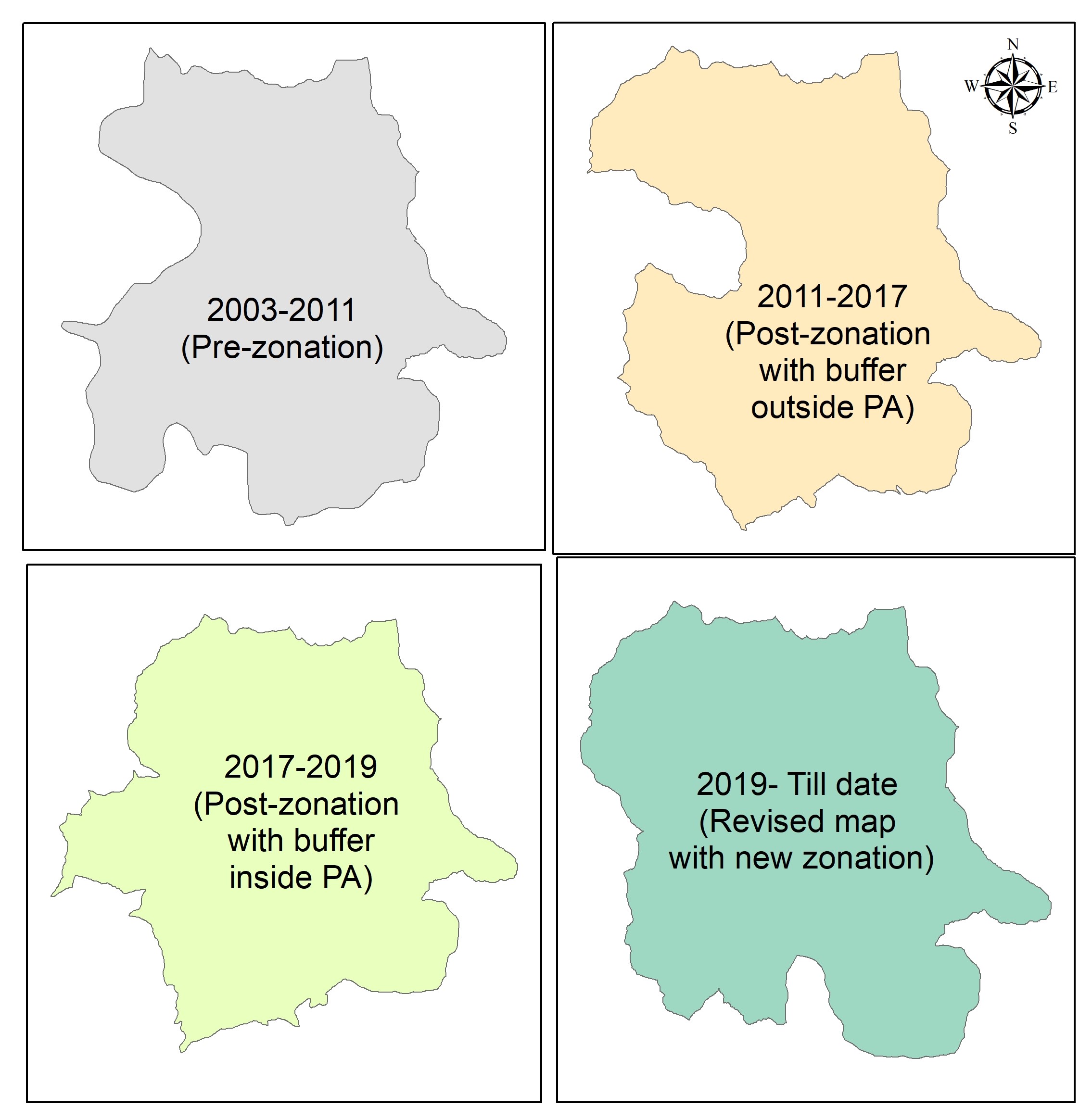Background
Sakteng Wildlife sanctuary was established in 2003. The sanctuary is located between 27.18039°-27.48626° North and 91.77719°-92.12475° East with altitude ranging from 1500 m in low lying subtropical to 4500 m in alpine meadows. It covers an area of 742.46 sq.km with 11.28% (88.77 sq. km) designated as core zone, 18.5% (137.4 sq.km) as transition, 52.94% (393.07 sq.km) as multi purpose and remaining 17.26% (128.30 sq.km) as buffer zone. However, the sanctuary officially manages (provide service) up to 937.62 sq.km (entire Merak and Sakteng Gewog). The sanctuary has three Ranges (Shown in the figure below) viz. Merak Range, Sakteng Range, and Joenkhar Range. Sakteng Range is the largest range with an area of 333.67 sq.km followed by Merak Range (287.352 sq.km) and Joenkhar Range (121.442 sq.km).
Broadly, the sanctuary is divided into three climatic zones viz. subtropical, temperate, and alpine zone. The sanctuary has 12 land use types (Table 1). There are 10 major forest types ranging from warm broadleaf forest till Alpine meadows. Majority of the area falls in a temperate zone. Sanctuary outlets three major rivers viz. Gamri chuu benefiting valley of Sakteng, Joenkhar, Phongmey, Radhi, Bidung, Samkhar, and Trashigang; Nyera ama chuu benefiting Merak, Kangpara, Gomdar, Thrimshing; and Jomo chuu benefiting Khasitang, Lauri, Serthi, and Daifam. The rivers are fed by approximately 104 individual lakes in the alpine area and seasonal rainfall. The area receives highest rainfall in June-August with sporadic snowfall from October-April.
| LULC | Area (sq.km) | %Cover |
| Alpine Scrubs | 88.06 | 11.88 |
| Broadleaf | 127.34 | 17.18 |
| Built up | 0.31 | 0.04 |
| Chirpine | 0.03 | 0.004 |
| Fir | 176.89 | 23.86 |
| Kamzhing | 1.88 | 0.25 |
| Water bodies | 2.80 | 0.38 |
| Landslides | 0.38 | 0.05 |
| Meadows | 40.23 | 5.43 |
| Mixed conifer | 216.43 | 29.19 |
| Rocky Outcrops | 0.25 | 0.03 |
| Shrubs | 86.79 | 11.71 |
Table 1. Land use types under SWS based on LULC 2016.
There are 872 plants, 130 species of orchids, 41 species of Rhododendrons, 280 birds, 37 species of mammals, 63 butterflies, 5 reptiles, 3 amphibians, and 2 species of fishes (BS 2015). It harbors highest diversity of Rhododendron species in the country with three endemic, R. kesangiae, R. bhutanese, and R. pogonophyllum propounding it as “Paradise of Rhododendrons”. Nationally important flora species like Meconopsis gakyidiana, Panax pseudogensing, Paris polyphylla, Taxus baccata, Pinus bhutanica, and Potentilla spp. Charismatic mammal species like Tiger (Panthera tigris), Common leopard (Panthera pardus), Black Panther (Panther pardus), Marbled Cat (Pardofelis marmota), Himalayan Asiatic Black bear (Ursus thibetanus), Clouded leopard (Neofelis nebulosa), Musk deer (Moschus chrysogaster), Red Panda (Ailurus fulgens), and Dhole (Cuon alpinus). Monal pheasant (Lophophorus impejanus), Tibetan Snow cock (Tetraogallus tibetanus), Snow Patridge (Lerwa lerwa), Indian Roller (Coracias benghalensis), Wood snipe (Gallinago nemoricola), Himalayan Griffon (Gyps himalayensis), Blood pheasant (Ithaginis cruentus), and Satyr Tragopan (Tragopan satyra) are few important bird species in the sanctuary. Further, the Khaling Torrent Catfish (Parachiloglanis bhutanese) is found in the sanctuary. Additional species of flora and fauna are expected through intensive exploration.
Despite having diverse flora and fauna in the sanctuary, the area is under tremendous pressure from anthropogenic activities. The sanctuary covers Merak and Sakteng under Trashigang dzongkhag. Closely 5000 semi-nomad inhabitants of Merak and Sakteng resides within the sanctuary. Almost 83 % of the inhabitants depend on livestock for their daily income and sustenance.
Vision
- To maintain integrated conservation & development of SWS, Relinquish intact cultural and natural resources to the next generation.
Mission
- Preservation of unique cultural and traditional heritage along with diverse Eastern Himalayan Terrestrial Ecosystem.
Mandates
- Conservation of unique natural and cultural heritage.
- Socioeconomic development.
- Resource allocation.
- Research and documentation.
Chronology of Sanctuary managers and the maps
Following officials served as the park manager/CFO of the sanctuary.

Since its establishment, map of the sanctuary also underwent several changes as shown in the photo below.

